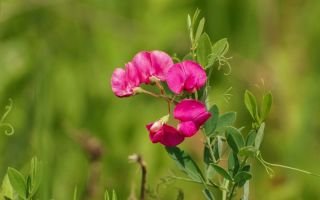Content
The use of the rank of meadow in folk medicine is very diverse. The plant is used for intestinal, vascular and colds, and green parts or ripe fruits are added to food.
What does the plant look like
The meadow rank (Lathyrus pratensis) is a herbaceous perennial plant from the legume family. It has a thin creeping rhizome and strongly branched weak stems, slightly flattened and hollow from the inside. The shoots of the plant are usually of the climbing type.

The leaves of the meadow rank are lanceolate, narrow, with antennae at the ends. In the second half of June, the plant produces bright yellow moth flowers in sparse racemes at the tops of the stems. By autumn, it bears fruits - elongated sessile beans up to 3.5 cm long with several dark, rounded seeds inside.
In addition to the meadow rank, there are several more plant species:
- Tuberous (Lathyrus tuberosus) - perennial with stems up to 80 cm long blooms in loose clusters of 3-7 purple-red buds. Distributed in Europe, Siberia and the Far East, China and the Caucasus.
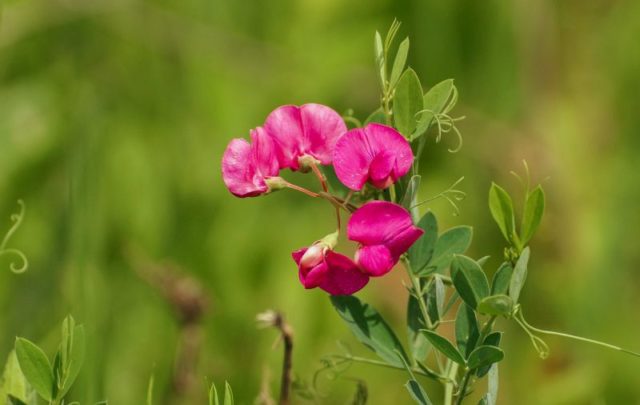 The tuber-bearing rank prefers steppe meadows and chernozem soils
The tuber-bearing rank prefers steppe meadows and chernozem soils - Forest (Lathyrus sylvestris) - a plant with a stem up to 2 m long and pointed leaves. Brings pink buds in small clusters of up to eight, pedicels can be straight or deflected.
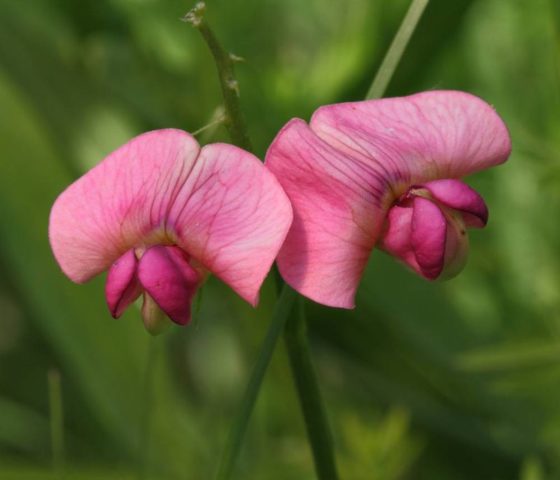 The forest rank grows in Europe and in the Caucasus regions in the thick of bushes and on forest edges
The forest rank grows in Europe and in the Caucasus regions in the thick of bushes and on forest edges - Pea (Lathyrus pisiformis) - reaches 80 cm in height, has bare stems and oblong-oval, sometimes narrowed, leaves. The brushes of this variety are dense, consisting of 6-20 reddish-purple buds.
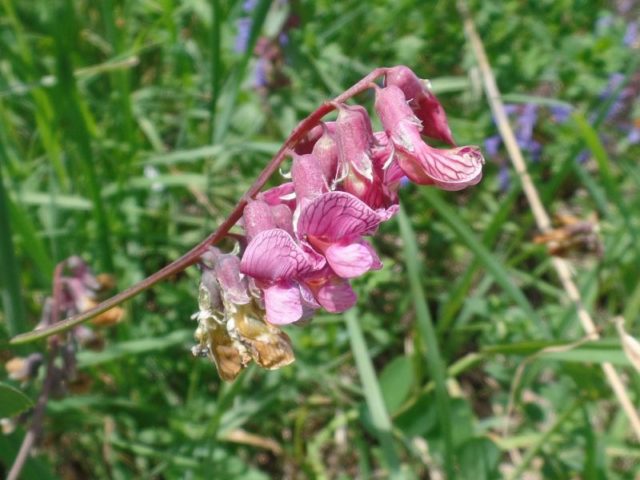 The pea rank is widespread in Central Asia, China, Altai and Siberia
The pea rank is widespread in Central Asia, China, Altai and Siberia - Japanese (Lathyrus japonicus) is a rather rare variety that grows in coastal areas in the North Pacific Ocean. You can meet the culture in meadows, pebbles, in the sands. China rises only up to 30 cm, its leaves are elliptical, the inflorescences are loose purple brushes, consisting of an average of five buds.
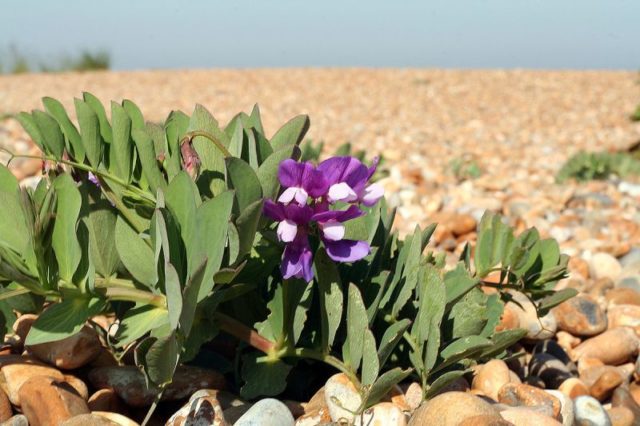 The Japanese rank is also called sea peas.
The Japanese rank is also called sea peas.
All varieties have medicinal properties. But the most popular in folk medicine is the meadow rank, since in the temperate climate of the Northern Hemisphere it is most widely represented.
Where does the rank meadow grow
The meadow rank can be found everywhere in European countries, in central Russia, in Siberia and in the Far East. The herb grows in most regions of Asia and the Caucasus, thrives in North America and even Africa, in Japan and Korea.
For the life of the rank he chooses thin forests with fertile soils and steppe meadows. Prefers well-lit areas, although tolerates light shade.
Rank composition
Photos of the meadow rank and its use in folk medicine are of interest due to the composition of the plant. The leaves, stems and roots of perennials contain:
- protein compounds and fats;
- bitterness and saponins;
- zinc, copper and sodium;
- carotene and retinol;
- vitamin C;
- potassium, magnesium and sulfur;
- caffeic and ferulic acids;
- leucine and alanine;
- kaempferol and quercetin;
- tryptophan;
- cobalt, phosphorus and nickel;
- histamine;
- cellulose.
The rich chemical composition endows the meadow rank with numerous beneficial properties. In official medicine, the plant is not used, but it can often be found in home health recipes.
Medicinal properties of the rank
When used correctly according to prescriptions, the medicinal meadow rank improves the condition of the body. In particular, the plant:
- normalizes liver function and accelerates digestion;
- helps with dysentery;
- promotes recovery from colds, bronchitis and pneumonia;
- relieves eye inflammation and accelerates the healing of mucous membranes;
- strengthens the immune system;
- normalizes intestinal peristalsis and helps fight constipation;
- improves blood circulation and benefits with varicose veins and a tendency to thrombosis;
- lowers blood sugar;
- improves the state of the nervous system and helps fight insomnia;
- normalizes blood pressure and strengthens blood vessels;
- has a tonic effect.
The meadow rank is used for heart diseases, including for recovery after heart attacks and strokes.
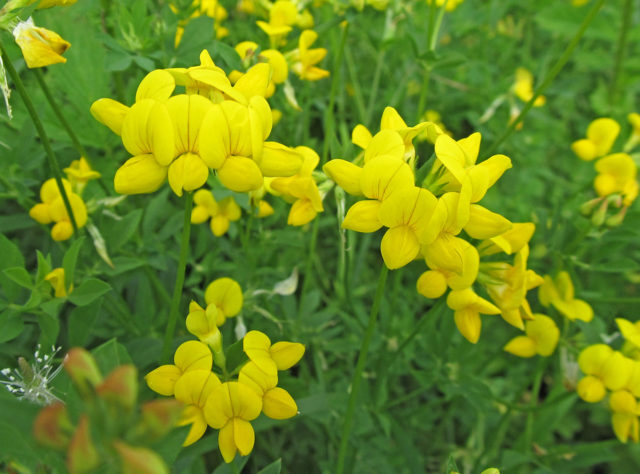
Preparation and application methods
Traditional medicine recommends several remedies based on the meadow rank. They can be used internally and externally.
Decoction of roots
For acute digestive disorders and pain in the heart, a decoction of the roots of the rank helps. It is prepared according to this recipe:
- dry raw materials are crushed in the volume of two small spoons;
- pour a glass of boiling water;
- simmer in a water bath for 15 minutes, and then insist for another two hours.
The filtered medicine is taken two large spoons up to four times a day.
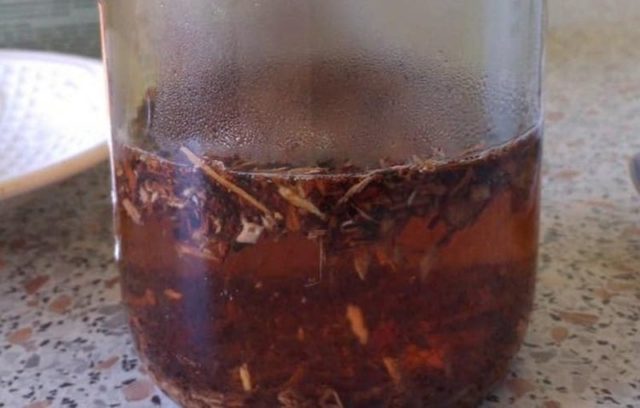
Infusion of leaves
One of the options for using the tuberous rank and other plant species is to prepare an infusion of leaves and stems. Traditional medicine gives this recipe:
- dried raw materials are measured in the volume of a small spoon;
- pour 250 ml of boiling water;
- cover the container with a lid and leave for two hours;
- filter through cheesecloth.
The ready-made infusion is consumed in 15 ml three times a day on an empty stomach. The remedy is beneficial for colds and bronchitis, relieves cough and promotes the discharge of phlegm.
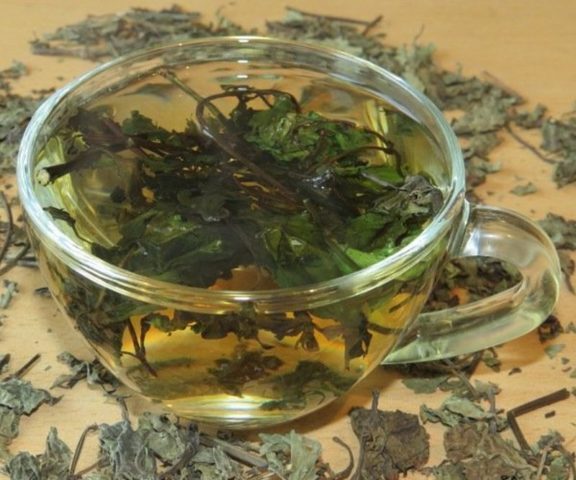
Fresh leaves
For purulent wounds, skin inflammations and burns in the healing stage, you can use fresh leaves of the rank for lotions and compresses. They contain organic acids and vitamins that reliably disinfect damage and speed up the process of tissue repair.
Young plates are washed in cool water after collection, slightly dried, and then kneaded with a crush. Green gruel is applied to a clean cloth or gauze and applied to a sore spot for 30-40 minutes.

The use of the rank of meadow in folk medicine
Traditional medicine offers several recipes using meadow rank. Each of them requires careful observance of proportions and dosages.
For heart disease
With tachycardia, arrhythmias and other diseases of the myocardium, a decoction of leaves and stems of the rank is used for medicinal purposes. Prepare it like this:
- a small spoonful of dry grass is poured with a glass of liquid;
- bring to a boil and simmer for another ten minutes over low heat;
- removed from the stove and insisted closed for an hour.
You need to take a decoction of 15 ml up to four times a day. It should be consumed on an empty stomach, shortly before meals.
With diarrhea
The use of forest ranks and meadows is in demand for diarrhea. The plant has anchoring properties and helps to restore healthy peristalsis. The drug is done as follows:
- grind the roots of the meadow rank in a volume of 15 g;
- pour raw materials with a glass of hot water;
- stand on low heat for 15 minutes;
- leave under the lid for half an hour and filter.
The broth should be drunk four times a day in a large spoon. Usually, on the first day of use, the meadow rank gives the desired effect.
With bronchitis
A decoction of meadow stalks helps to get rid of a lingering cough and speed up recovery from bronchitis. The recipe looks like this:
- dry grass is crushed in a volume of 5 g;
- steamed raw materials with a glass of boiling water;
- stir and leave under a lid in a warm place for half an hour.
The finished product must be filtered. They drink the infusion three times a day, a large spoonful, the treatment continues until the condition improves.
For insomnia
With a bad dream, you can prepare an infusion of the meadow rank. Traditional medicine recommends this recipe:
- a small spoonful of dry grass is poured with 250 ml of hot water;
- cover the vessel with a lid and leave for an hour at room temperature;
- the cooled agent is passed through cheesecloth.
You need to take the infusion in a large spoon during the day at intervals of 3-4 hours.
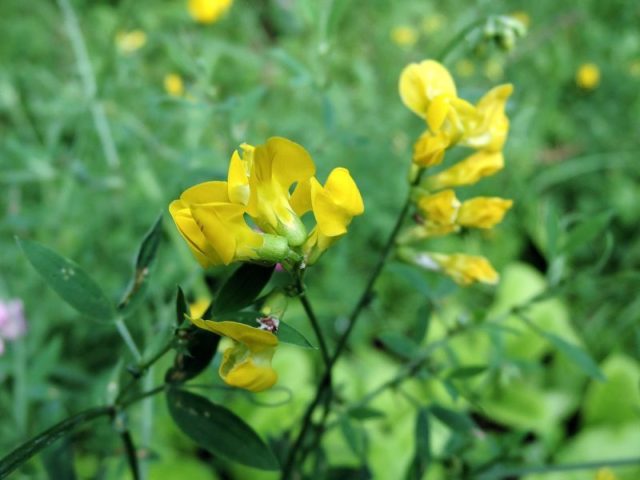
With hypertension
The benefit of the rank is that the medicinal plant evens out the pressure, relieves migraines and heart palpitations with hypertension. For medicinal purposes, such a remedy is prepared:
- 10 g of dry leaves and stems are measured;
- raw materials are poured with 250 ml of hot liquid;
- leave to infuse closed for four hours;
- filter through cheesecloth.
You need to take the infusion in a small spoon every 2-3 hours. The treatment is continued until the pressure normalizes. Also, the infusion of the meadow rank can be drunk to strengthen the immune system and at the first symptoms of a cold.
With thrombophlebitis
Meadow rank thins the blood well and improves the condition with varicose veins and thrombophlebitis. From protruding veins, spider veins and heaviness in the legs, this infusion helps well:
- 10 g of dried plant roots are brewed with a glass of boiling water;
- cover the container with a lid and leave for six hours;
- passed through folded gauze.
You need to use the drug up to six times a day in a small spoon.
Cooking applications
The beneficial properties of ranks are used not only in traditional medicine. The fruits of the plant contain a large amount of protein and are weakly inferior in nutritional quality to lentils, beans and peas.
Boiled rank beans are used in the Caucasus, and in Asia they are crushed and made nutritious flour. Fresh leaves and shoots of the plant are added to soups and salads. China is a good honey plant, although bees extract little pollen from its flowers, only about 20 kg per hectare.
Contraindications
The meadow rank is considered a fairly safe plant and rarely causes harm to the body. It is recommended to refuse its use:
- with individual plant intolerance;
- with a tendency to flatulence and gas formation;
- with chronically low blood pressure;
- with increased nervous excitability;
- with frequent bleeding.
Pregnant women should use the meadow rank only with the permission of a doctor. Breastfeeding mothers are advised not to take the plant for food or medicinal purposes in order to avoid allergies in the infant.
Harvesting rank meadow
The collection time depends on which parts of the plant are to be used for medicinal purposes or for cooking. Leaves and stems for the preparation of medicinal infusions and decoctions are best harvested during the flowering period, when they contain a maximum of useful substances.The collected raw materials are laid out in an even layer on a tray and dried in a shaded but warm place with good ventilation. It is also allowed to use an oven or electric dryer, but the temperature should be set no more than 50 ° C.
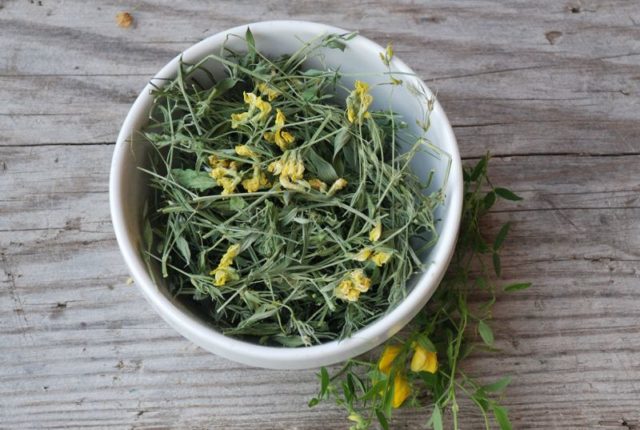
As for the roots of the rank, they are dug up immediately after the snow melts or in late autumn, shortly before frost. The plant should be at rest, during this period all useful substances are concentrated in its underground part. After harvesting, the roots are thoroughly washed from the soil and dried in air or in a warm oven.
It is necessary to store medicinal raw materials in sealed glass containers or paper bags. China is kept at room temperature, with low humidity, away from sunlight.
Conclusion
The use of the rank of meadow is in demand in folk medicine for gastrointestinal and heart diseases. The plant improves myocardial function, helps with indigestion and helps to get rid of coughs. The herb has few contraindications; it rarely harms the body.

